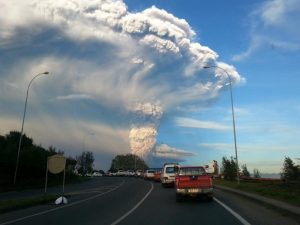
When the Earth absorbs solar radiation, the planet heats up. Some of that energy escapes back into space as electromagnetic radiation, but certain gases in the atmosphere can trap the electromagnetic radiation, warming the planet like a blanket.
A longstanding question involves whether gases emitted by volcanoes help trap energy on a global scale. Specifically, water vapor—which traps more radiation in the atmosphere than any other gas, alone accounting for half of the greenhouse gas effect—is of great interest to scientists studying volcanoes and global climate change. In theory, the force of eruptions could inject water vapor into the stratosphere, where the water vapor could reside for months and cause significant warming. Days after Mount St. Helens erupted in 1980, for example, researchers measured increased water vapor in the stratosphere, but little evidence has emerged since then that moderately explosive eruptions significantly increase the amount of water vapor in the stratosphere. Still, numerous studies have attempted to model the impact that water vapor spewed from volcanoes has on the global climate.
Here Sioris et al. took measurements from the 2015 eruption of the Calbuco volcano in Chile to see how much vapor a moderate-sized volcanic eruption would spew into the stratosphere. The researchers used the Aura satellite to take samples of the water vapor in the volcanic plume following the eruption. This is the first time that satellite observations have been used to determine the total amount of water vapor injected into the stratosphere by a volcanic eruption, giving researchers a more representative data reading than in situ observations used in an earlier study.
The satellite data revealed that the ratio of water vapor to dry air reached 14 parts per million by volume in the stratosphere days after the eruption. The researchers found that this significant vapor enhancement from Calbuco, as had been observed following Mount St. Helens, persisted for only a few days in the stratosphere. Using the data in this study and the measurements of other eruptions, the authors confirm that moderate-sized volcanic eruptions do not deliver enough water vapor to the stratosphere on timescales long enough to consistently contribute to the greenhouse effect.
Reference:
Direct injection of water vapor into the stratosphere by volcanic eruptions. DOI: 10.1002/2016GL069918
Note: The above post is reprinted from materials provided by Eos-American Geophysical Union. The original article was written by Alexandra Branscombe. The authors. CC BY-NC-ND 3.0










